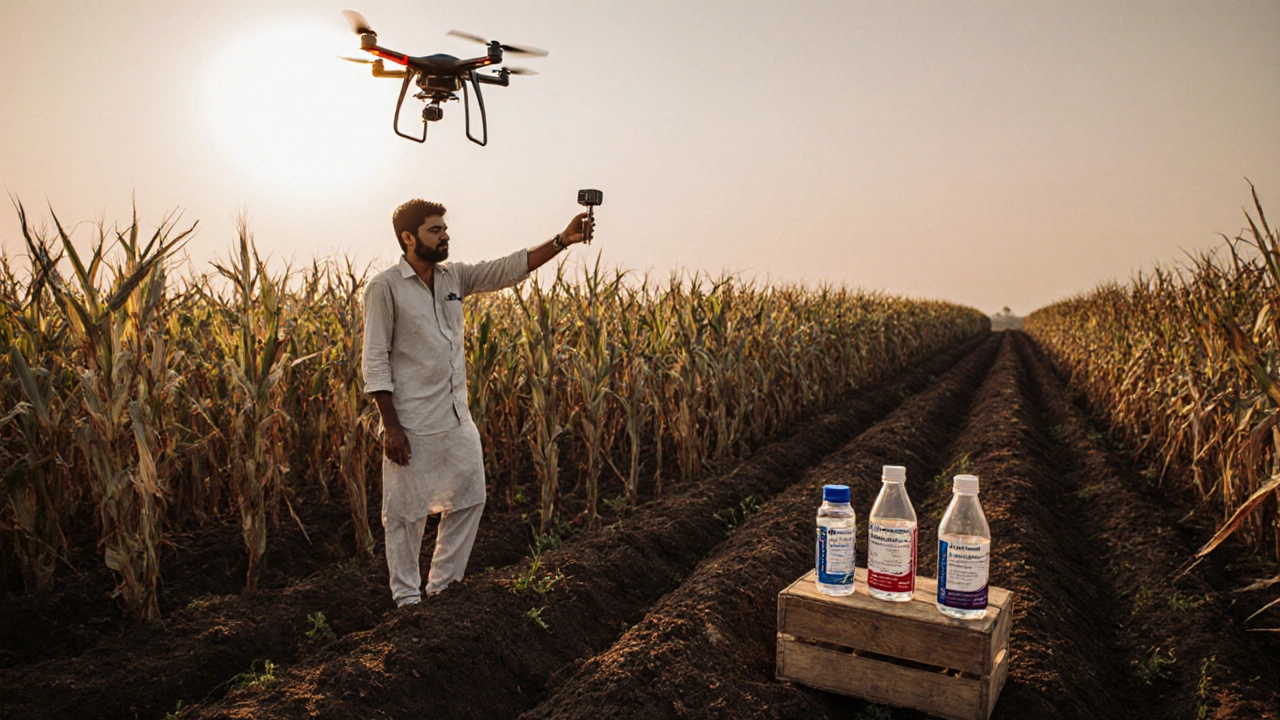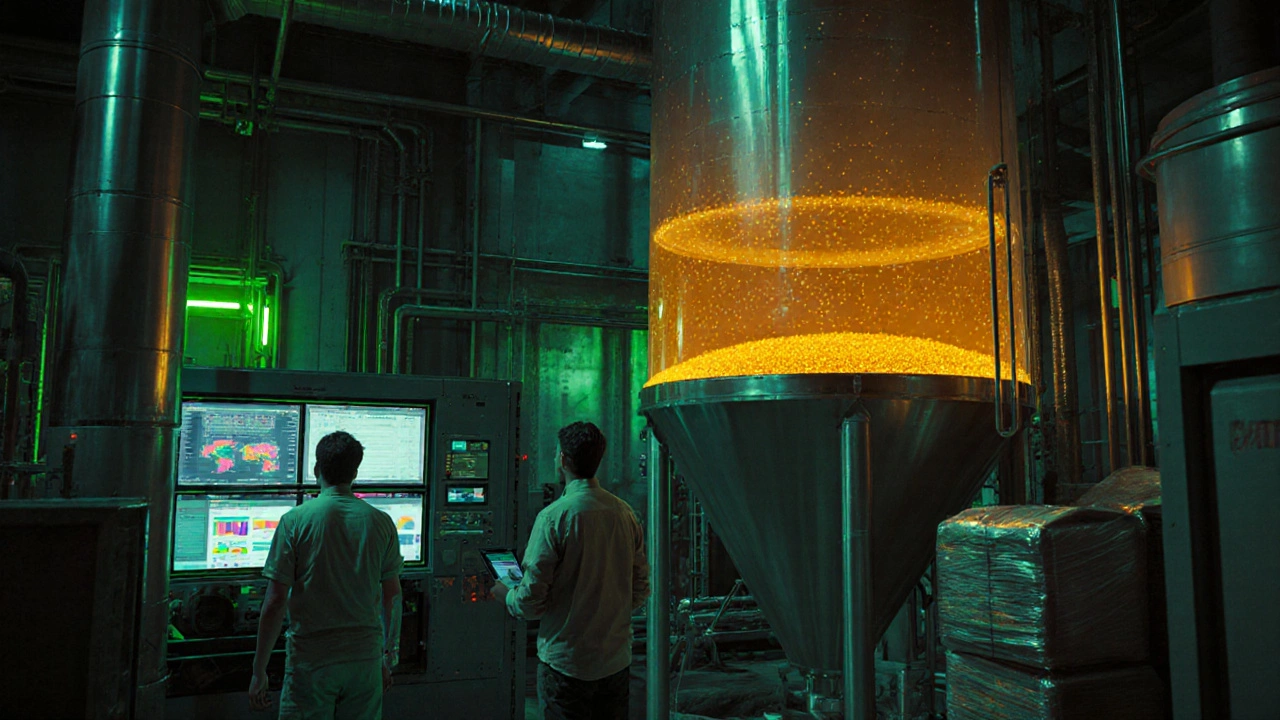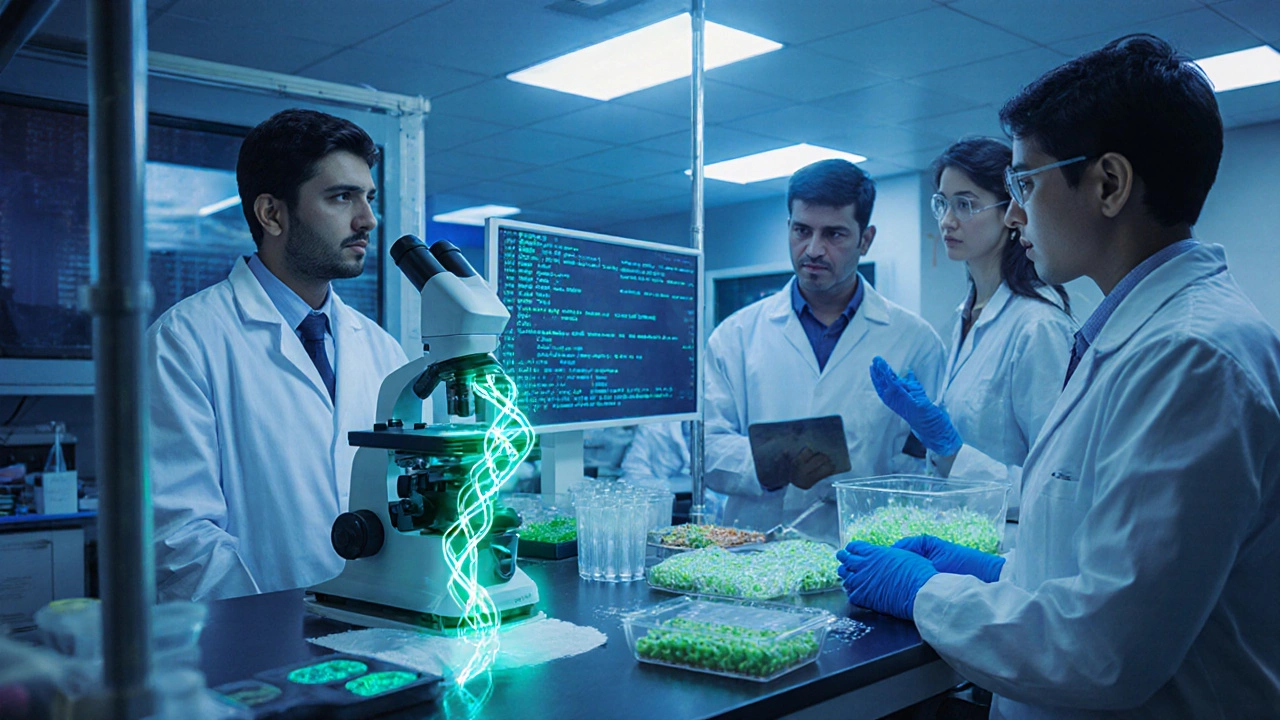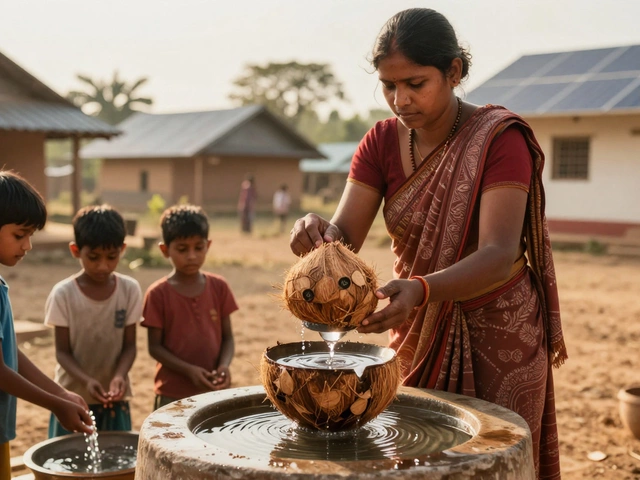Biotech Crop Yield Impact Calculator
How Biotech Crops Can Transform Agriculture
Modern biotechnology creates crops that thrive in extreme conditions. For example:
- Drought-tolerant maize in Maharashtra shows 30% higher yields during dry spells
- Sub1 rice survives two weeks underwater, helping farmers in flood-prone Odisha and Bihar
Modern biotechnology isn’t just lab coats and test tubes anymore. It’s changing how we grow food, treat diseases, clean up pollution, and even make clothes. If you think biotech is still stuck in the 1980s with recombinant DNA and insulin-producing bacteria, you’re missing what’s happening right now-in Bangalore labs, in Indian farms, and in clinics across the world.
What Exactly Is Modern Biotechnology?
Modern biotechnology is the use of living systems and organisms to develop or make products, but with tools that are faster, smarter, and more precise than ever before. It’s not just about copying genes anymore. It’s about editing them like text, designing new biological circuits, and engineering microbes to do jobs nature never intended.
Think of it this way: old biotech was like using a typewriter to rewrite a book. Modern biotech is like using a word processor with autocomplete, spell-check, and the ability to delete entire paragraphs without touching the rest.
The core difference? Precision. Tools like CRISPR is a gene-editing tool that lets scientists cut DNA at exact locations. It’s cheaper, faster, and more accurate than older methods. That’s why you’re seeing it in everything from disease-resistant rice to clinical trials for sickle cell anemia.
CRISPR and the Gene-Editing Revolution
CRISPR-Cas9, developed in the early 2010s, is the biggest leap in biotech since PCR. It’s not science fiction-it’s in use right now. In 2023, the first CRISPR-based therapy was approved in the UK and US to treat sickle cell disease. Patients who once needed lifelong blood transfusions are now living symptom-free.
In India, researchers at the Indian Institute of Science in Bangalore are using CRISPR to develop varieties of mustard and chickpea that resist pests without pesticides. That’s not just science-it’s food security.
CRISPR isn’t perfect. Off-target edits can happen. But new versions like base editing and prime editing are fixing those flaws. These aren’t just upgrades-they’re next-gen tools that can change a single DNA letter without cutting the strand. It’s like correcting a typo instead of rewriting the whole sentence.
Synthetic Biology: Building Life from Scratch
Modern biotech doesn’t just edit life-it builds it. Synthetic biology is the engineering of biological parts to create new functions. Imagine programming bacteria to produce biofuels, or yeast that makes spider silk for sustainable fabrics.
Companies like Ginkgo Bioworks designs custom microbes for industries are working with fashion brands to grow dyes instead of using toxic chemicals. In India, startups are using synthetic biology to make plant-based meat alternatives that taste like real chicken-without raising a single animal.
This isn’t just about products. It’s about rethinking supply chains. Instead of shipping oil-based plastics from China, imagine growing biodegradable packaging in a fermentation tank in Hyderabad. That’s already happening in pilot plants across Karnataka.
Biotech in Agriculture: Feeding the Future
India grows over 150 million tons of food every year. But climate change is making droughts and floods more common. Traditional farming can’t keep up.
Modern biotech is answering with crops that don’t just survive-they thrive. Scientists at ICAR have developed rice that can survive two weeks underwater. That’s called ‘Sub1’ rice, and it’s already helping farmers in Odisha and Bihar recover from floods.
Then there’s drought-tolerant maize. In Maharashtra, farmers using this variety report 30% higher yields during dry spells. No GMO labels. No controversy. Just better harvests.
And it’s not just about crops. Biotech is also helping soil. Microbial inoculants-living bacteria that fix nitrogen or unlock phosphorus-are replacing chemical fertilizers. In Tamil Nadu, over 200,000 farmers now use these bio-fertilizers. The soil is healthier. The cost is lower. The yield? Higher.

Medical Breakthroughs: From Treatment to Cure
Biotech is turning chronic diseases into manageable conditions-and sometimes, into curable ones.
Car-T cell therapy, once a $500,000 treatment only available in the US, is now being offered in India at a third of the cost. Hospitals in Delhi and Mumbai are using it to treat blood cancers that didn’t respond to chemotherapy.
Then there’s mRNA vaccines. After the pandemic, India ramped up its mRNA production. Now, homegrown mRNA vaccines for dengue and tuberculosis are in late-stage trials. These aren’t copies of Western tech-they’re adapted for Indian strains and costs.
And it’s not just drugs. Biotech is enabling personalized medicine. A patient in Chennai can now have their tumor sequenced, and a treatment plan built just for their genetic profile. That’s not futuristic. It’s happening today.
Environmental Biotech: Cleaning Up with Biology
Biotech isn’t just about making things-it’s about fixing them.
Oil spills? Bacteria engineered to eat hydrocarbons are being tested in Gujarat’s coastal waters. Plastic waste? A fungus found in the Western Ghats can break down polyurethane in weeks. That’s not a lab curiosity-it’s a solution being scaled.
In Bengaluru, a startup is using algae to capture CO2 from factory smokestacks and turn it into bioplastics. The algae grow faster than trees, absorb more carbon, and don’t need farmland. It’s a circular system: pollution becomes raw material.
Even wastewater treatment is getting a biotech upgrade. Traditional plants use energy-heavy aeration. New systems use microbes that clean water without oxygen. One plant in Pune cut its energy use by 60%.
What’s Next? The Next Five Years
What will biotech look like in 2030? Here’s what’s already on the horizon:
- Organoids: Miniature human organs grown in labs to test drugs without animals or human trials.
- Gene drives: Technologies that could eliminate malaria-carrying mosquitoes in rural India.
- Biological computing: DNA used to store data-1 gram of DNA can hold 215 million gigabytes.
- At-home diagnostics: A drop of blood on a paper strip, scanned by your phone, tells you if you have dengue, TB, or diabetes.
These aren’t distant dreams. Labs in Hyderabad, Pune, and Delhi are building them now.

Challenges Still Ahead
It’s not all smooth sailing. Regulatory delays in India slow down approvals. Public fear of GMOs still lingers, even when the science is clear. And access? A CRISPR therapy might cost ₹5 lakh-too high for most.
But India’s strength isn’t just in labs. It’s in scale. With over 1.4 billion people, if biotech works here, it can work anywhere. That’s why global companies are partnering with Indian institutions-to build affordable, scalable solutions.
The real challenge isn’t the science. It’s making sure the benefits reach everyone-not just the wealthy.
Why This Matters to You
Modern biotech isn’t something happening ‘out there.’ It’s in your food, your medicine, your water, and your air.
When you eat a tomato that doesn’t rot in a week? That’s biotech.
When your child gets a vaccine that was designed in weeks, not years? That’s biotech.
When your city’s rivers get cleaner because microbes are eating the pollution? That’s biotech.
This isn’t about science for science’s sake. It’s about survival. About health. About feeding a growing planet without destroying it.
And India? We’re not just using these tools. We’re reshaping them.
Is modern biotechnology the same as genetic engineering?
Genetic engineering is one part of modern biotechnology, but not the whole picture. Modern biotech includes gene editing (like CRISPR), synthetic biology, biomanufacturing, tissue engineering, and bioinformatics. Genetic engineering focuses on altering genes, while modern biotech uses those changes as tools within larger systems-like engineering microbes to produce medicines or cleaning up pollution with engineered bacteria.
Are CRISPR-based treatments available in India?
Yes. India has approved clinical trials for CRISPR-based therapies for blood disorders like beta-thalassemia and sickle cell disease. Hospitals in Delhi, Mumbai, and Bengaluru are conducting these trials, and the first commercial treatments are expected by 2026. The cost is being kept low through local manufacturing partnerships.
Is biotech safe for the environment?
It depends on how it’s used. Engineered organisms are rigorously tested before release. Many environmental biotech applications-like using microbes to clean oil spills or break down plastic-are designed to be self-limiting: they die off once their job is done. The bigger risk isn’t the tech-it’s poor regulation. India’s guidelines are improving, but enforcement needs to keep pace with innovation.
How is Indian biotech different from Western biotech?
Indian biotech focuses on affordability and scalability. While Western companies often develop high-cost therapies for wealthy markets, Indian labs prioritize low-cost solutions for large populations. For example, Indian mRNA vaccines were designed to work without ultra-cold storage. Similarly, bio-fertilizers and drought-resistant crops are made for smallholder farmers-not agribusinesses.
Can I access biotech-based healthcare in rural India?
Yes, slowly. Mobile diagnostic kits using biotech-like paper strips that detect dengue or TB from a single drop of blood-are being distributed through rural health centers. Government programs are partnering with startups to bring these tools to villages. In some districts, ASHA workers now carry biotech-enabled diagnostic devices. It’s not everywhere yet, but the infrastructure is being built.
Where to Learn More
If you want to understand biotech beyond headlines, start with the work of institutions like the Indian Institute of Science (IISc), the National Institute of Immunology (NII), and the Council of Scientific and Industrial Research (CSIR). Many of their research papers are open-access. Follow how startups like Strand Life Sciences, Biocon, and Curefoods are applying biotech in real ways.
Biotech isn’t a mystery. It’s a toolkit. And right now, India is learning how to use it-not just to compete, but to lead.





